




We made it!
Christmas always seems to be a time when we reflect on the year gone by, but we think 2022 has been a year of looking forward. So, despite the economic challenges, we are still seeing a massive surge of new products hitting our shelves & our team is excited for what 2023 will bring!
There has been a noticable & considerable push towards ethical & sustainable products that are credible & great tasting. Some of our highlights come from producers such as Tap Social Movement. They are a craft brewery and hospitality social enterprise that creates employment and training opportunities for ex-offenders. Another increasingly popular producer is Sapling Spirits. A British spirits producer making their vodka & gin exclusively in the UK to reduce transport emissions. Furthermore, for every bottle you buy, sapling will plant a tree in local community in areas from london across to bristol.
Thank you for supporting independent business. We wish you not just a merry christmas & a peaceful new year but a consistent one at that!
Kindest regards, The team at Inn Express

Behind their smiles and slick service hospitality workers can fall upon hard times just like anybody else. Ours can be a stressful industry, with long hours, high pressure environments and physically demanding work.
From hotels, restaurants, pubs, bars and cafés to schools, hospitals and event venues Hospitality Action is here to give everyone in hospitality the help, advice and support they need whenever times get tough.
Serious illness, mental health issues, financial difficulties, family problems or addiction: whatever challenges you face, Hospitality Action is always here to get you back on your feet and enjoying the job again. And, when it’s no longer possible to work, we help people prepare for the next phase of their lives.
Hospitality Action helps in a number of ways, as well as offering financial grants they offer mental health support and signposting, provided via an online advice hub and 24 hour helpline.
Meanwhile Hospitality Action’s Employee Assistance Programme provides comprehensive wrap-around support with access to counsellors and experts in areas such as law or finance. Developed specifically for the industry the scheme also features managerial advice resources and support in the event of a critical incident and currently protects over 160,000 employees.
As hospitality people face soaring energy bills, rocketing rents and inflation, coupled with the staffing crisis and rising cost of living Hospitality Action have led to mounting and heart-breaking pleas for help to our industry charity.
Over the autumn Hospitality Action experienced in applications for financial support applicants are presenting with household arrears or utilities placing many at risk of homelessness.
Meanwhile 35% of our beneficiaries are now directly referencing mental health issues in their application, reporting that this is exacerbated by financial problems.
The good news is that Hospitality Action is working harder than ever to support our industry and we continue to adapt our services to meet the demands of the industry we serve.
To learn more about Hospitality Action please
www.hospitalityaction.org.uk


The inn-express.com online ordering portal is live, and all customers can now register for an online account. This platform exclusively offers Inn Express customers an unrivalled range of products teamed with live stock availability.
Whether you use our answerphone system, emails or call our customers service team, transitioning from your existing way of ordering will always be a scary thought. So we, thought we’d add some helpful FAQ’s so you can navigate your way through the process of logging on for the first time, through to placing your order and viewing previous orders.
With a click of a button you can now receive email notification when a product returns into stock
Search within a chosen category to get to where you want faster
If you are a pay on delivery account you are now able to pay easily and quickly through the website. We now accept Apple pay & Google pay
Add a group of products to your wishlist and create an order at your convenience
Like a particular producer? Simply click on the ‘discover more’ button and see more from them.
A new layout brings extra tools. View cummulative spend, see your most popular products and dive into the exciting world of invoices! Wooooo
INN EXPRESS ARE ABLE TO OFFER AWARD WINNING COFFEE AT COMPETETIVE PRICING. BUT BY PARTNERING WITH TRUE INDUSTRY EXPERTS WE CAN NOW HELP MAKE YOUR HOT DRINKS SELECTION IS WORKING AS HARD FOR YOUR BUSINESS AS YOU DO!

Inn Express has partnered with the Coffee Collaborative team to offer a free-of-charge equipment solution. A Grigia Compact ME 2 group traditional coffee machine and two world-class Macap on-demand grinders are up for grabs. The espresso machine & grinder has been refurbed and professionally serviced by market leader Mulmar.
To secure the 2-group traditional machine, commit to purchasing a minimum of 1000kg of coffee PA (around 200 cups per day*)
To secure one of the grinders, commit to a minimum of 500kg of coffee PA.
The deal is simple. Purchase excellent Coffee Collab coffee via Inn Express; the kit is yours.**
There are no strings, no marks ups, just superb coffee and fantastic revenue opportunity. But hurry, the machines are limited. When the deal is gone, it’s gone!
on a 14g espresso shot
available
account manager
For those who are rocking the coffee opportunity but feeling the economic pinch… Coffee Collaborative guarantee not only award-winning coffees at the best commercial terms, but with our partners at Inn Express, we also have a super deal to turbocharge your revenues.

Again, it’s simple – Buy 10 cases of superb coffee (you don’t have to purchase all in one go – carry on ordering as usual), but when you get to the magic 10 cases, ‘ hey presto’ we will happily pop a free case in with your next order!
At typical retail and assuming a 14g double shot, that’s £1250 free revenue!
This offer is available to everyone.





Pure booch is authentically slowed brewed pure kombucha.
Unlike other brands on the market its raw and unpasteurised keeping it real with live cultures and bacteria.

Pure booch is low in sugar, naturally flavoured and free from preservatives.


Grapefruit / Original / Cranberry / Ginger & Lime
a can— so that

In an industry bloated with ‘heritage this’ and ‘tradition, that’, we think there’s room for a brand like us. A brand that sets itself apart in how it thinks, the way it goes about things, the drinks it creates, and how it expresses itself.

Our classic london dry gin, gin 77, infused with rich flavours of ripe blackcurrant and blackberry.
A luscious and refreshing gin, exploding with flavours of ripe, juicy white peach!


Our classic london dry gin, with fresh grapefruit zest, root ginger, and pink peppercorns.
Empirical is forever inspired by the role flavor plays in our ability to create and transport experiences.

Delicately fizzy, can 01 leads with an acidic gooseberry flavor balanced by a flowery oolong tea, and rounded out by freshly cut toasted birch and an undercurrent of pomelo zest.



Just crack it open.Effervescent, enlivening, fruity... Walnut wood gives a sturdy depth to the notes of zesty sour cherry, aromatic black currant buds and lemony maqaw pepper.
Opens with citrusy front notes of lemongrass, lemon myrtle, and andaliman pepper. Carob, coffee chaff, and golden yunnan tea provide a warming earthy depth with the fragrant coconut-like fig leaf rounding out this highly refreshing blend.
An intriguing mixer that bills itself as being the alternative to lemon and lime when it comes to cocktails. It's produced with distilled water alongside five different types of acid (citric, malic, tartaric, succinic and phosphoric) to mimic the acidity of citrus fruits, as well as a pinch of sugar and salt.




To give the world a hard seltzer that was easy on the taste buds. Something light and refreshing, that used natural ingredients. That had all of the flavour and none of the fuss. But most importantly, something with great taste.

Raspberries / Pear



To many of us Mulled wine is usually a warming winter drink based on a cheap and inferior red wine to which spices are added to mask the flavour, but you won’t find anything inferior about the ingredients in Hitzkopf “Classic” Glühwein, in fact you won’t find any red wine either.

What makes it so special is that it is a 100% fruit wine, based on the
fermentation of fresh fruit and berries, setting it apart from its low grade alternatives, as well as containing far less sugar.
All the ingredients are hand-picked and 100% natural, there are no artificial colourings, sweeteners or flavourings to be found. Hitzkopf Glühwein is Glutenfree, and fully suitable for Vegetarians and Vegans.

This delicious alcohol-free punch can be enjoyed by adults as much as children.
fruity hot drink combines the juice of apples, currants and elderberries, seasoned with cinnamon and cloves
BIB £27.99
Btl £4.29







A family dedicated to wine production for 80 years. Thanks to the experience and a great family history, we have managed to develop superlative quality wines that fully express the characteristics of our terroir.
Gran Corte

Pair with steak, fine cuts of exotic game. Rich, baked-cheesebased dishes



Pair with grilled game, steak, misogrilled aubergines
45% Cabernet Sauvignon, 20% Merlot, 10% Malbec, 10% Bonarda, 5% Petit Verdot, 5% Syrah, 5% Tannat
Pair with grilled red meats, lamb, game, stews, or strong cheeses.
Patagonia is Argentina’s most southerly wine region and for winemakers it offers a cooler climate, numerous hours of sun and abundant water.The style here displays a distinct homage to Burgundy with a celebration of delicacy, elegance, and pure fruit expression.




Pair with duck and mild game dishes
Pair with sea bass wrapped in pancetta

So, what are the benefits of drinking organic wines? How do they differ from conventionally made wines and what’s happening in the global wine industry to help facilitate this burgeoning interest?
The obvious one, for anyone who cares about the planet, is the benefit to the environment. Working organically in the vineyards means no addition of harmful, man-made chemicals so no chemical fertilisers, herbicides, fungicides or pesticides. This not only improves soil health but also supports a more balanced local ecology and it’s kinder to the vineyard workers too (although it is more labour intensive).
Being more labour intensive is also a plus because organic wine estates create more jobs than non-organic wine estates.
We’ve already touched on the fact that there are no artificial chemicals used in an organic vineyard. It’s a similar story in the cellar regarding the use of artificial additives and preservatives, but it’s worth pointing out that there’s no universal set of rules around organic winemaking. It’s broadly the same across Europe but the rules are even tighter in the US, for example, around the addition of sulphites. Every country effectively sets its own standards that’s enforced by its own government-backed independent body.
Is it possible to taste the difference between organic and non-organic wines? Do organic wines taste better? While taste is always going to be subjective, a couple of recently published studies have shown that organic wines have performed better in professional independent tasting reviews than conventional wines. One study was conducted exclusively on US wines and the other on French.
One of the key differences between organic and conventional winemaking is that most

organically certified wines are either strictly limited or forbidden from receiving added sulphites in the form of SO2 (Sulphur Dioxide) during the winemaking process.

SO2 is a natural by-product of alcoholic fermentation, in very small quantities, but it can also be added as a preservative to prevent the wine from oxidising. Conventional wines, especially those that are bulk-produced, typically receive high levels of SO2 in the winery in addition to regular additions of powdered sulphur when the fruit’s picked.
There is a caveat to consider here. Less or no use of SO2 means that the wines are potentially less stable and, in theory, won’t be able to age as long, so are intended for earlier drinking. Not necessarily a bad thing.
In practise, producers with good hygiene and a high level of attention to detail can minimise this risk.
The brand new Inn Express wine collection has been released.

The new portfolio is released just in time for those looking to futureproof their menu and or upgrade to stay in line with modern consumer trends and habits.

Organic wine sales in the UK are still on the rise and are predicted to continue strongly over the next decade. The picture is mirrored in other key wine consuming markets around the globe; Germany, the US, France and Scandinavia to name a handful.























The dessert and sweet fortified wine categories are probably the most overlooked within the on-trade, often resembling an afterthought on a wine list rather than a worthwhile addition to compliment or round off a meal. As new wine drinkers drive the desire to experiment with their wine choices, whether at home or when they eat out, there’s an opportunity to bring some of these great wines to their attention and gain incremental sales.
One of the benefits of serving sweet wines is that they have a much longer drinking window than dry wines once they’ve been opened, so they’re ideal to offer by the glass. The high sugar levels help to slow down oxidation and sweet fortified wines like tawny port, which are made in an oxi dative way, can last up to 2 months once opened.
Due to the way many dessert wines are made and the limited quantities produced, they’re bottled in smaller formats from 50cl down to 18.7cl, with half bottles (37.5cl) being the most widely used. This is another benefit to the on-trade as it ena bles a quicker turnover of stock.
The ideal serving measure for dessert and for tified wines is 75ml and there’s no shortage of glassware that accommodates this, but larger measures could equally be offered, especially if it’s a lighter sweet wine like a sparkling Moscato.
Rather than lose your dessert wine options at the back end of your wine list, why not feature them with your desserts on the menu and even offer a set price for say a cheese platter with a nominat ed glass of port or dessert wine. It’s also worth offering the wine or port on its own, as one of the dessert options, as it can make a great talking point at the end of the meal.

There’s a golden rule when it comes to sweet wine pairings and that is make sure the dish doesn’t overpower the wine in terms of sweetness or flavour. More often than not, a sweet wine will pair just as well or better with something savoury so it’s worth keeping this in mind too. For a little inspiration, here are some of our favourite pairings:
The alter ego to Vintage Ports, Tawny Ports achieve their colour and intense nutty flavours through extended ageing in cask as opposed to bottle and are much more mellow by the time they’re bottled. The age on the label references the average age of the ports in the blend, so there will be some older ports as well as younger but it’s indicative of the style.
Also great with: The intensity and complexity of this port can stand up to Christmas Pudding and can even handle brandy butter, which is notoriously difficult with other sweet wines.


Lightly sparkling and naturally low in alcohol (usually around 5%), Moscato d’Asti is the gluggable sweetie from Italy’s Piedmont region. Araldica make a fab example under their Alasia label which has the ideal balance between grapey sweetness and energetic freshness. It’s a Christmas staple as it pairs perfectly with I
Also great with:
Italian Christmas cakes like panettone and pandoro. It also works with warm, light sponges and fresh fruit tarts that haven’t been over-sweetened.
One of the richest dessert wines affected by the famous ‘noble rot’ or botrytis, Sauternes is a classic dessert wine from the Bordeaux region of France. Noble rot is a natural fungus that thrives in humid conditions, attacking the skins of the grapes and causing them to shrivel to raisins.

Also great with: Crème caramel or crème brûlée as well as with Roquefort and Saint Agur cheeses. It’s also highly popular with rich pâtés.
Another Christmas indulgence is Ruby-style Port and good quality Stilton like Colston Bassett or Cropwell Bishop. Ruby Ports are essentially young Vintage Ports that have done most of their ageing in bottle rather than in cask. The key difference between these two styles of port is ageing. Fine Ruby spends around 2 years in large oak vats while LBV spends between 4-6 years maturing. Both can be enjoyed straight from the bottle without the need to decant.
Also great with: Along with their Fine Ruby Port make ideal partners for blue cheese but the LBV can also pair with chocolate and berry desserts.

No, we’re not talking about Premier League Football or even Premiership Rugby come to that. I’m referring to the fact that autumn is officially the season for putting game back on the menu, and with game come the big-hitting wines to compliment.

The primary considerations when selecting wines to partner with any food is to try and match the core components of the dish, like weight, spiciness and intensity of flavour, as closely as possible to the components in the wine.
In the case of game, it means focusing on wines that have more richness and textural weight in the mouth, slightly lower acidity in the case of white wines and moderate, ripe tannins in the case of reds but try to avoid too many earthy, bitter tannins. Noticeably oak-aged wines will be better-suited to the spicier and gamier dishes.
Let’s explore the two-legged and four-legged game options out there before setting our sights on a few wine recommendations.
Sustainable, widely available. Birds such as Pheasant & Partridge are crammed full of vitamins plus low in saturated fat and cholesterol.

On any day we’re a massive fan of carefully oaked whites from cooler zones, especially Chardonnay. One of the best value examples we’ve tasted most recently is the Montsablé Chardonnay from the Pays d’Oc region in southern France. This wine is bang on for milder flavoured game like whole roasted partridge and pheasant, in place of chicken, or serve it alongside a warm partridge or pheasant salad with pan-fried breast meat.
Sourced from established hillside vineyards in the Limoux sub-region, the limestone soils impart a freshness that gives the wine a similar profile to that of the Maconnais in southern Burgundy. A small component of the wine (20%) is aged in French oak for just three months, so the wood flavour is subtle, but the textural weight is enhanced.
There’s a bunch of other wild birds that can be hunted and served up, too, with varying strengths of gamey flavours. Three are wild ducks - from the most delicate in taste; these are Teal, Mallard and Wigeon. Wood Pigeons are plentiful and available all year round with a lovely wild flavour, while Woodcock, Snipe and Red Grouse are the strongest flavoured and have a narrower season similar to Pheasant and Partridge.

Technically a four legged game animal but when it comes to venison, we have six species roaming wild, all of which are delicious in their own right but also distinctly different from one another.
Muntjac is the mildest of all and most tender with a fabulous texture and the perfect intro to venison meat. Similarly, Fallow deer is relatively mild tasting with a subtle gaminess and makes an ideal intro to the category.

Chinese Water Deer has a lot of fat and is probably the easiest to cook as a result as the fat prevents the meat from drying out. It’s full of flavour but not gamey. Sika Deer has a similar texture to fallow, but the game flavour is more pronounced and, like Chinese Water Deer, is fattier too, which adds to the flavour and keeps the meat tender as it cooks.
Both Roe and Red Deer are the gamiest, with red being the most commonly eaten venison. Both require a little more care when cooking in order to avoid drying out.
The red wines from southeast Spain, close to Valencia, are not only becoming more fashionable but deliver great value for money too. The little DO of Manchuela sits on one of Spain’s highest plateaux, meaning it’s relatively easy to work organically and biodynamically, thanks to the prevailing winds keeping the vineyards free of disease.
Bodegas Altolandon is a family domain with wife Rosalía in charge of winemaking. Their Mil Historias Bobal has always impressed us for its bright, silky concentrated fruit, flecked with floral and herb notes. For a wine that wears the ‘natural wine’ mantle, there’s not even a hint of funk. There’s enough power behind this wine to match up to richer and stronger game dishes like Jugged Hare or venison sausages and mash.

Another Sustainable, widely available option. In the UK, the four-legged game comprises grey squirrel, wild rabbit, hare and venison. Squirrel is becoming more widely accepted, and with such an abundance around us, we should be encouraged to serve it up more.
The Rhône valley produces red wines that are absolutely ideal with rich game dishes. In the southern Rhône, the combination of juicy Grenache with smoky Syrah forms the foundation for most of the blends this region is famed for.

We all know of Côtes du Rhône, which is a pretty broad generic appellation for the entire region but move up a notch to Côtes du Rhône Villages, and things get a lot more interesting. Domaine Boutinot’s ‘Les Coteaux’ Côtes du Rhône Villages is a clever blend in every sense of the word. They blend the best fruit sourced from selected growers from different named villages and bring it all together into a forward, expressive and well-balanced wine. There’s ripe bramble fruit in abundance with subtle warming spices, all of which lends itself perfectly with slow-cooked or braised squirrel and rabbit or with pan-fried Wood Pigeon breast. It also works with milder venison like Fallow Deer and Muntjac.
It’s encouraging to see more and more pubs and restaurants promoting our native game and getting ever more creative with it. Not only is it healthier than traditionally farmed meats, but it’s sustainable too. Go to www.eatgame.co.uk to learn more about game, where to source it, and some inspirational recipe ideas.




The brand new Inn Express wine collection has been released. The new portfolio is released just in time for those looking to futureproof their menu and or upgrade to stay in line with modern consumer trends and habits.

In addition to fine-tuning the range, we’ve added more insightful and educational material that we hope you will find beneficial and will help provide some useful pointers when you come to review your wine lists. With the worst of the pandemic hopefully behind us and now the prospect of another economic downturn, offering consumers even greater value needs to be a priority. We’ve written a lot recently about alternative grape varieties and better-value lookalikes to some of the most popular wines, so this would be a great place to start exploring. We’ve highlighted our growing range of biodynamic, natural, organic and sustainable wines throughout our portfolio.


inn-express.com or call our team on



The first thing to remember about orange wine is that it is not made of oranges. The second is that it’s not really orange. Helpful huh?
Orange wine is a type of white wine made by leaving the grape skins and seeds in contact with the juice, creating a deep orange-hued finished product. In other words, it’s like making red wine with white grapes. When making white wine, you typically remove the skin from the grapes before fermenting; with red wine, you leave the skin on. Orange wine mixes up this process by using white grapes but leaving on the skins. The result is a far richer and more full-bodied drink than regular white wine. This is also how it gets its colour, which is much deeper than a white wine ranging from pale amber to deep orange.
Most orange wines taste like a bolder, more savoury version of wines from the same white grape. Generally speaking, orange wines display mild flavours of stone fruit like peaches, tea flavours like strong oolong and an impression of honey without actually being sweet.










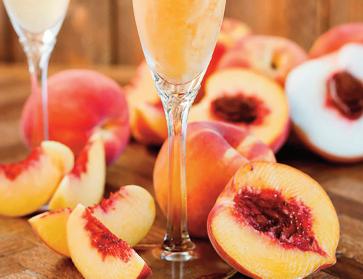








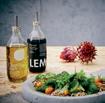

Each and every bottle of Lemonaid and ChariTea helps development projects. The same goes for our upcycled vases, lights, sugar shakers, etc. For every purchase, a fixed donation is made to Lemonaid & ChariTea e. V. Perhaps you fancy buil-ding your own furniture and household


items? We’ve teamed up with the ingenious Ghostbastlers to make “how-to” videos for you. You can find them here: lemon-aid.de/upcycling You’ll see some of the end results of our brainwaves in the photo on the right. We can’t wait to see your creations!
What’s the idea behind Lemonaid & ChariTea?

We want to make things better. We want to use organic, fair-tra-de ingredients to make great drinks that contribute to a good cause – ins-tead of manufacturing artificial, sugary concoctions that just line the pockets of huge corporations. The same goes for our other projects. Take our upcycling ideas, for example. The world already has more than enough cheap plastic tat. We prefer to craft solutions that re duce rubbish rather than producing it. We’ve joined forces
with the ingenious Ghostbastlers to design a whole world of creative and handy household items for you – items that are easier on the eye and are much more appealing than any massproduced product. Our bottles and crates have been transformed into lights, seats, soap dispensers, vases, sugar sha-kers and much more. Suitable for homes, cafés or clubs. More information available at www.lemon-aid.de/ upcycling






















get 1 case of BUY 4 cases , razza , f ree!







Lemons get a sweet and tangy twist in Razza, our punky pink lemonade. Fruity, fizzy and fearless he get’s his feel-good flavour from natural raspberry, organic lemons and fairtrade organic cane sugar — so he tastes good, and does good too.






























































































































































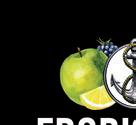




50ml dark rum



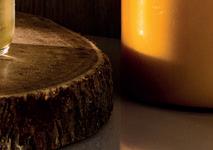













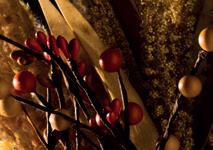









Freshly squeezed lime

Top up with Frobishers Ginger and Juniper Spectacular Sparkler Method



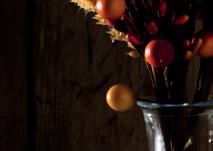



Fill a highball glass with ices and add the rum. Freshly squeeze in some lime and top up with Ginger and Juniper Spectacular Sparkler. Garnish with a sprig of mint or a slice of lime.




Make ice count – use bigger cubesfor a bit more oomph, and to stop the drink diluting down.








With their feet firmly in organic soil, multi-award-winning Gusto Organic offer a range of delicious premium soft drinks. All are organic and vegan certified and carry the Fairtrade logo, with ingredients that support farmers from around the globe.

Each drink offers a unique blend of flavours made from the finest fruits, spices, extracts and essential oils. The Gusto range is free from refined sugar, artificial sweeteners and preservatives and has been created to give consumers better non-alcoholic choices.
glass









harnessing the healing powers of plants, we ' re on a mission to reconnect young people with the magic of nature outside & in! we pledge 10% of our profits to rewilding projects and charities that provide greater access to green spaces and encourage young people to rediscover, enjoy and protect nature.





A few years ago, our founder Florence, was on holiday in New York and had been told by some friends she had to try a Pickleback; a shot of whiskey followed by a shot of pickle juice. The whole concept seemed bonkers, but once she tried it she was hooked, and began to find a way to bring it back to London. She started playing around with different pickle recipes, to come up with a pickle juice created spe cifically for drinking in cocktails and juices; not just the left over brine from a jar of pickles.


After many months crafting the recipe, Florence came up with a delicious blend brewed for a minimum of twelve weeks with sliced cucumbers and spices; creating a flavour both sweet and savoury. This became our Original Pickle Juice.
With salts and vinegars full of rehydrating electrolytes, and tur meric acting as a great anti-inflammatory, the juice has amaz ing health benefits.



With bartenders quickly getting on board with our pickle juice, we began coming up with different alcoholic and non-alcohol ic cocktails it could be used in. One everyone agreed on, was that it was the perfect addition to a Bloody Mary.
And so came The Pickle House Spiced Tomato Mix. A blend of tomato juice, fresh horseradish, spices, and our Original Pickle Juice, all conveniently in one. This unique mix boasts an unforgettable flavour with pickle juice adding both depth and smoothness.












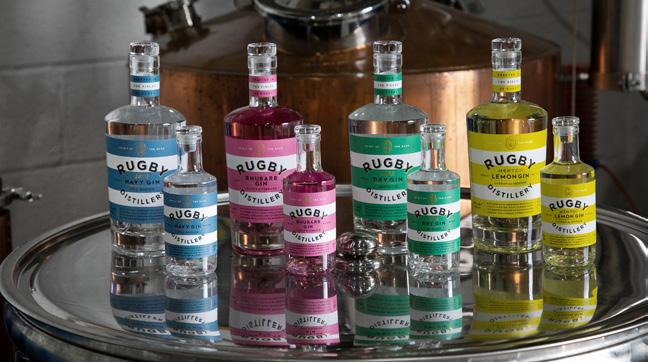
We are a family owned and run business, producing small batch spirits with a unique and distinctive connection to both the place of Rugby and the game.

We pride ourselves on crafting bold spirits using British-sourced ingredients and botanicals to create unique flavours with a superior quality.
There isn’t a better combination for Rhubarb than Campari! This bright & blissful mix is great for fruity gin lovers.

50ml Rugby Rhubarb Gin
25ml Campari
25ml Lemon Juice
50ml Rhubarb and Strawberry Syrup Egg White or 35ml Aquafaba
Combine all the ingredients into your cocktail shaker
Shake for 15 seconds without ice
Shake with ice for 12-15 seconds
Strain into a coupe glass



“Damson No 12 is so well balanced and a very quaffable hip-flask ready product.”
GUIDE
with a truly sustainable conscience.
Gattertop Drinks Cº is at the forefront of orchard-inspired, organic spirits. Owing its namesake to the historic Herefordshire farm called Gattertop which dates back to 1086. All the ingredients used to flavour premium British vodka are hand-picked from orchards steeped in history. Sustainably driven Gattertop Drinks is committed to preserving and protect ing the orchards, safeguarding the landscape that they rely on to produce their meticulously crafted organic vodka spirits.


Premium British sugar-beet vodka is steeped in whole damsons for a mini mum of 12 months creating a deep and distinctive gluten-free vodka, unique to Gattertop. Characterised by an initial sharp burst of flavour followed by more subtle notes of almond and marzipan to finish. Delicious on its own over ice or in a wealth of cocktails, Damson Nº12’s strength is in its versatility.
Focusing on the natural flavours from the historic orchard at Gattertop and working harmoniously with nature, Botanic Nº7 champions classic English countryside ingredients of nettle, elderflower, blossoms, basil and rosemary.

Scoring 96/100 at the 2021 IWSC, Botanic Nº7 became the highest scoring vodka in England and later achieved the UKs silver award for best Botanical/infused vodka at the 2022 World Vodka Awards proving the testament of ‘what grows together, goes together.’







Naturally flavoured, Herefordshire vodka
a truly sustainable conscience.

Whisk(e)y is no longer exclsuively for bearded men with pipe & slippers in hand. The landscape is changing! But, since the meteoric rise of Gin, you can walk into many bars & see almost endless amounts of gins in all flavours on the back bar.
So it can be said that whiskey sometimes had to sit & play second fiddle, sometimes third. But don’t waste space on your back bar. Maximise your whisk(e)y offering & offer all customers an excellent experience in cocktails, simple serves or by providing a well-curated range. You stand to make more money, more margin & gain some additional customers.

Much like wine, a bottle of whisky can tell a whole host what to expect when you open the bottle. Akin with its grapebased liquids, though, is the same level of confusing jargon on the label! Fear not! Read below and become a wee legend in your lunchtime!
SINGLE MALT SCOTCH WHISKY
A Scotch Whisky distilled at a single distillery from water and malted barley without the addition of any other cereals, and By batch distillation in pot stills. Single Malt Scotch Whisky must be bottled in Scotland.
SINGLE GRAIN SCOTCH WHISKY
A Scotch Whisky distilled at a single distillery from water and malted barley with or without whole grains of other malted or un-malted cereals
BLENDED SCOTCH WHISKY
A blend of one or more Single Malt Scotch Whiskies with one or more Single Grain Scotch Whiskies.
BLENDED MALT SCOTCH WHISKY
A blend of Single Malt Scotch Whiskies, which have been distilled at more than one distillery.
BLENDED GRAIN SCOTCH WHISKY
A blend of Single Grain Scotch Whiskies, which have been distilled at more than one distillery.
Highland, Lowland, Speyside, Campbeltown, and Islay. These names can only appear on whiskies wholly distilled in those regions.
This must not be used as a brand name on any Scotch Whisky which has not been wholly distilled in the named distillery.
KEEP

An excellent starting point for any budding Whisky connoisseur is to know the Scottish producing regions and the distinct flavours each region imparts on its products





Modern consumers are actively looking for something unusual or different to the norm. Although a dedicated menu is proven to be biggest influencer of purchase among these consumers, a basic knowledge of your whisk(e)y range can be just as effective a sales tool.

Once home to 30 distilleries, the mighty have fallen far indeed. Now home to only two operational distilleries, Campbeltown is lonely these days. The whiskies produced here, Springbank & Glen Scotia, are very similar to Islay malts & have a peaty, briny character.

The largest whisky-producing region of Scotland, if not one with the most distilleries; only about 30-ish in total. The trouble with the region being so large is that there’s a lot of variations in the tastes. The western Highland distilleries have a fair amount of peaty taste to them, & tend to be sweet & dry, while the North Highland whiskies tend to be light, spicy & dry. The rest of the whiskies in the Highlands are generally fruity, but not quite to the same degree as the Speysides. They still have a dry finish
Ah, Islay. Some of the most distinctive tastes in Scottish Whisky come from this region, which is rich in peat bogs & sea spray. Despite its small size, it has some of the most famous distilleries in Scotland- a fame brought about by the (non-too-coincidental) peaty character of most of its whiskies. The Islay whiskies are not for everyone. Variously described as “medicinal”, “cough syrup”, “barbecue”, “chao-da”, these drams are something of an acquired taste.
The Islands are sometimes lumped together with the Highlands, but there’s just enough variation that it deserves a brief mention here. The Islands are fairly diverse geographically, with some on the northern tip of Scotland (Orkney) & some on the central portions (Jura, Skye). Island whiskies tend to be peatier & slightly saltier than their Highland counterparts, but not quite as extreme as their Islay cousins.
The region of Scotland closest to England, whiskies from the Lowlands are light, dry & fruity. These pecularities come from the triple distillation technique that’s commonly used. With whiskies being distilled thrice before being left to age in casks, most of the fats & other flavourful chemicals are removed from the spirit, leaving mostly alcohol & water. With much of the strong flavours removed, the whiskies are inoffensive & mellow making them well suited for people new to scotch.
Salty, Smokey & fruity aswell
From smooth & floral to powerful & peaty
Highly peated, very smokey & salty aromas
Peaty & Powerful
Fresh, Light & Floral. Often not as peated
By far the most important region for whisky production, the region is (imaginatively) named after the river Spey. Home to about 60 distilleries despite the small physical size of the region, it’s the most important region for whisky production by sheer volume
Gentle & Fruity
Whilst legend has it that grains were distilled in 13th-century China, it is widely accepted that Ireland was the birthplace of the water of life made from barley.
From anecdotal writings, it is known that whisky played a part in Ireland’s life from the 1400s, but the first official evidence seems to come from a 1556 Act of Parliament: “...graine in making of aqua vitae...”.
The first tangible proof of the spirit of barley from the Scottish Exchequer Rolls of 1494 states, “VIII bolls of malt to Friar John Cor wherewith to make aquavitae”. John Cor was a monk based at Lindores Abbey in Fife, which existed from the late 1100s to 1559. A boll was a Scottish measure which would have been the equivalent of just over 5 bushels, & this could have produced about 1000 bottles of spirit, but of course, we don’t know to what strength the final spirit would have been distilled.
Regardless, the vocabulary is Celtic; aqua vitae in Gaelic is uisge beatha, which became uisge and, ultimately, whisky. In both countries, distillation developed through the middle ages & by the 17th century, whisky drinking had become widespread. As a result, Charles I saw an opportunity to raise a lot of money; in 1644, the
Government imposed taxes on Scotch whisky & laws were passed restricting the rights of distillation to the landed classes. In Ireland, taxation began a few years later, in 1661. These taxes may have raised some money for the Exchequer, but they gave rise to illicit distillation. Either distiller made false declarations & sold quietly on the side, or more commonly, they disappeared into the countryside with their stills.
Across the Atlantic, the first wave of America’s Scots & Irish immigrants also brought distilling techniques. By the mid-1600’s applejack, peach brandy, & whisky were being produced along the East Coast. These pioneering colonists soon found that whilst barley was suited to British & Irish soils & climates, corn & rye would be much more rewarding crops in their new land. Couple this with a natural disposition for independence & rebellion, It is unsurprising that American whiskey branched off in a different direction regarding production methods & taste.
Head to head, Ireland led the way in whisky production, the first official distilling licence being granted in 1608, & one hundred years later, there were reckoned to be 2,000 stills in operation! However, just as Irish distillers probably introduced us to whisky, the country also was the first
to introduce traditional temperance societies; the establishment of the Ulster Temperance Society in 1818 heralded a century of rising prohibitionist tendencies which finally led to the Volstead Act in 1920, in the USA.
The American temperance moves, combined with the development of continuous distillation & the arrival of the phylloxera outbreak in Europe (which temporarily removed brandy from the market), led to the demand for whisky rocketing. Irish whiskey producers had been outselling Scotch before this time as they were more prominent in number & used unmalted barley, producing a more popular lighter spirit. The Scots took to the new Coffey stills as did the Canadians, & in these two countries, production advanced enormously; for a period in the 1860s & ’70s, Canada was the world’s largest producer of whisky, but in the 20th century, it was in Scotland that the industry powered ahead.
It is only after a minimum of 3 years of ageing that Scottish whisky can be called scotch. Some distilleries hold casks of whisky which are a grand 70+ years old.
All whiskies are the result of a mash of cereals & water that have been saccharified by enzymes, fermented by yeast & subsequently distilled before being aged in oak barrels & finally bottled. The typical cereal grains include:
With so many strains available today, distillers want to strike the right balance between quality & quantity yielded, they look for plump, ripe barley with plenty of starch & not too much protein or nitrogen. Used predominantly as malted grains.
Widely regarded as producing the weightiest of grain whiskies & the predominant grain in American Bourbon.
Produces lighter whiskies & along with maize produces most of the world’s grain whisky.
Used on its own, sometimes with a proportion of malted barley & often as the flavouring grain for many Canadian & US whiskies.
Single malts aside, many whiskies utilise a mix of grains depending on the required flavour profile of the brand.
This process is simply soaking the cereal grains in water. After approximately 48 hours, the moisture penetrates the grain. As a result, enzymes in the embryo move to the endosperm, its starch store, thus modifying it from a rigid structure to a fragile one & allowing germination. The germination process changes the chemical structure of the starch & the resultant sugars promote seed growth.
To Malt or not? Malting the grain eliminates the need to ‘cook’ the cereal to order for us to access the starch we will convert to sugars. Most malted grain comes from specialist maltsters who will effect the process pneumatically in either box or drum, which contain turners that keep the grain separate & ensure the free flow of air throughout the bed. Some malt is still produced on malting floors, where the grain is spread & regularly raked as it begins to germinate. As a result of converting starch to
maltose, rootlets & seedling shoots appear & the grains are now termed green Malt. To maximise fermentable matter & retain adequate diastatic power, this process is halted & the green Malt is sent for drying. For large-scale production of grain spirit destined for column distillation, the unmalted cereal is often cooked under pressure using steam, which softens the grain starch, rendering it soluble.
The kiln is usually a tower-shaped hot air chamber with a heat source, sometimes fan-assisted, below a wire floor where the green Malt is spread out to dry before milling. Here, the drying grain can pick up the smokey flavours if peat or wood chips are used or added to the heat source.
The extent to which the grains are milled is crucial to the effectiveness of the resultant grist as it determines the amount of starch that is extracted & converted to sugar during the
mashing stage. Too little & not enough starch will be exposed & converted into sugar. Too much & the floury consistency will stick, go soggy & prevent good filtration. Ideally, the grist should contain a good proportion of unbroken husks as these provide greater buoyancy in the mash & aid filtration in the mash tun—a cylindrical metal vat with rotating paddles. Different grains are milled separately when mixed grains are used, such as in Bourbon. These grains are measured so that the exact proportion of each grain is introduced to the mash cooker in the right sequence. This ensures all ingredients are processed at at the right temperature. Often a proportion of malted grain is used to give a starter effect to the fermentation process.
The grist is placed in a mash tun and combined with boiling water giving a slurry where the starch can dissolve, and the mixture is left for about an hour. Corn is a tough grain that must be cooked at extremely high temperatures under pressure to modify its structure. In contrast, wheat and rye are cooked at lower temperatures, the former to preserve their character and the latter to ensure that rye clumping, which can cause bacterial infection, does not occur. After several hours of cooking and cooling, a warm porridge-like product called
distiller’s beer will have about 6-8 % abv for rye mashes and up to 14% for corn. In the USA, an additional control on fermentation speed and flavour development is the amount of backset added (which must be a minimum of 25 % of the mash volume to be called sour mash). Backset is the spent grains from the previous
instances, a single column is used after the pot.
Shapes and sizes of stills vary between distilleries, but all affect double or triple distillation. The ferment sent to the first pot needs rummaging; otherwise, the solids may stick to the still’s sides and result in burnt aromas. Rummagers—rotating arms with webbing—are built inside these stills. The heat is turned on, the alcohol vaporises, and

mash is produced, where the process has converted the starch into sugar, which is either used directly or ‘lautered’ and washed out. For most Scottish and Japanese Malt and grain whiskies, a sweet liquor known as the wort is drained in successive washes. The wort is cooled and pumped into the fermentation vessels known as washbacks. The lautering process in Canada and the USA is often omitted, and mash is pumped directly to the fermentation vats.
Yeast is added to the cooled wort or mash, and fermentation begins; depending on factors including the type of yeast, the temperature and the type of grain, it will typically last about 48 hours, and the resultant

distillation, the lees leftover after the alcohol has vaporised; it is very acidic and thus slows fermentation, helps prevent bacterial infection and counters the natural alkalinity of the region’s water. In turn, the backset increases the complexity of flavours in the end product, aids consistency of character, and ensures a totally unique product after many generations of distillation.
The distiller’s beer is now ready to go into the still. Methods have evolved around tradition and convention. In Scotland, malt whiskies are distilled twice or thrice in a pot still, and all grain whiskies are rectified in column stills. In Ireland, both malted and unmalted grains can be pot distilled two or three times, whilst lighter grain whiskies are distilled in multi-column continuous stills. In many countries that use hybrid pots with or without short columns, standard in Europe and the USA, craft movement and distillation may utilise both methods. In some
the resulting low wines (about 20 % abv) are sent to the second pot, where the procedure is repeated. In the final distillation, be it the second or third, the first vapours or foreshots and the last vapours and feints are not potable and are returned to the first still to repeat the process. The heart of the distillate is collected, and this new whisky is approximately 70 % abv.
Although more brutal with the raw materials, the resultant whiskies can be more elegant. Typically utilising more than one column, steam is fed into the bottom of the first column, the analyser, and the wort is fed into the top. When the two meet, the alcohol vaporises and, together with the uncondensed steam, passes into the second column, the rectifier. The vapours rise to the top and are condensed and collected on a cool spirit plate. The

foreshots and feints are returned to the wash for re-distillation.
Before the spirit is transferred to casks, an initial reduction with de-mineralised water may be made to reduce the leaching of character from the oak. Straight whiskies (except corn) require ageing in new casks in the USA. Fortunately, many used barrels are available for other spirit producers, and therefore, much of the world’s whisky matures in second-use wood. Whisky can also be transferred to different casks for finishing; this imparts flavours from the new cask, such as sherry, wine or another spirit.
The location of the ageing warehouse is a significant factor. Whiskies matured by the sea will generally pick up coastal undertones and will be affected by the moderating influence of the Gulf Stream on the west coast of both Scotland and Ireland. Their respective east coasts are much cooler, and the rate of evaporation and maturation is slower.
In the case of Bourbon, whiskies are matured in either brick (cooler) or iron-clad (hotter) warehouses known as ricks which are generally about nine-storeys high. The vagaries of the climate are such that in summer, the top floors are unbearably hot, the bottom floors are pretty cool, and the top floors are quite warm while the bottom is cold. Therefore the
barrels on the top storeys are much quicker to mature than those on the bottom. In some countries, such as Canada, different whiskies and ages are blended before maturation. A blend is also not uncommon to be returned to ageing before bottling.

Some distilleries talk of moving barrels around to try and mature each barrel consistently, but this is generally admitted to be too labourintensive. Most blend barrels from each part of the warehouse or different warehouses together for consistency and a well-balanced, complex spirit. This blending is quite an art, as each distinct microclimate will bring the whiskey a different profile.
It has been said that if the distiller is a chemist. Then the blender is the artist. However, this miss-states the importance of both jobs. The blender skilfully marries the component bulk whiskies to ensure that the required flavour profile is available for bottling. This could involve blending one or more types and ages of spirits produced in a single distillery (typical of production in Canada, America and Ireland) or blending the whiskies from many distilleries, both Malt and grain (more typical of Scotland and Japan).
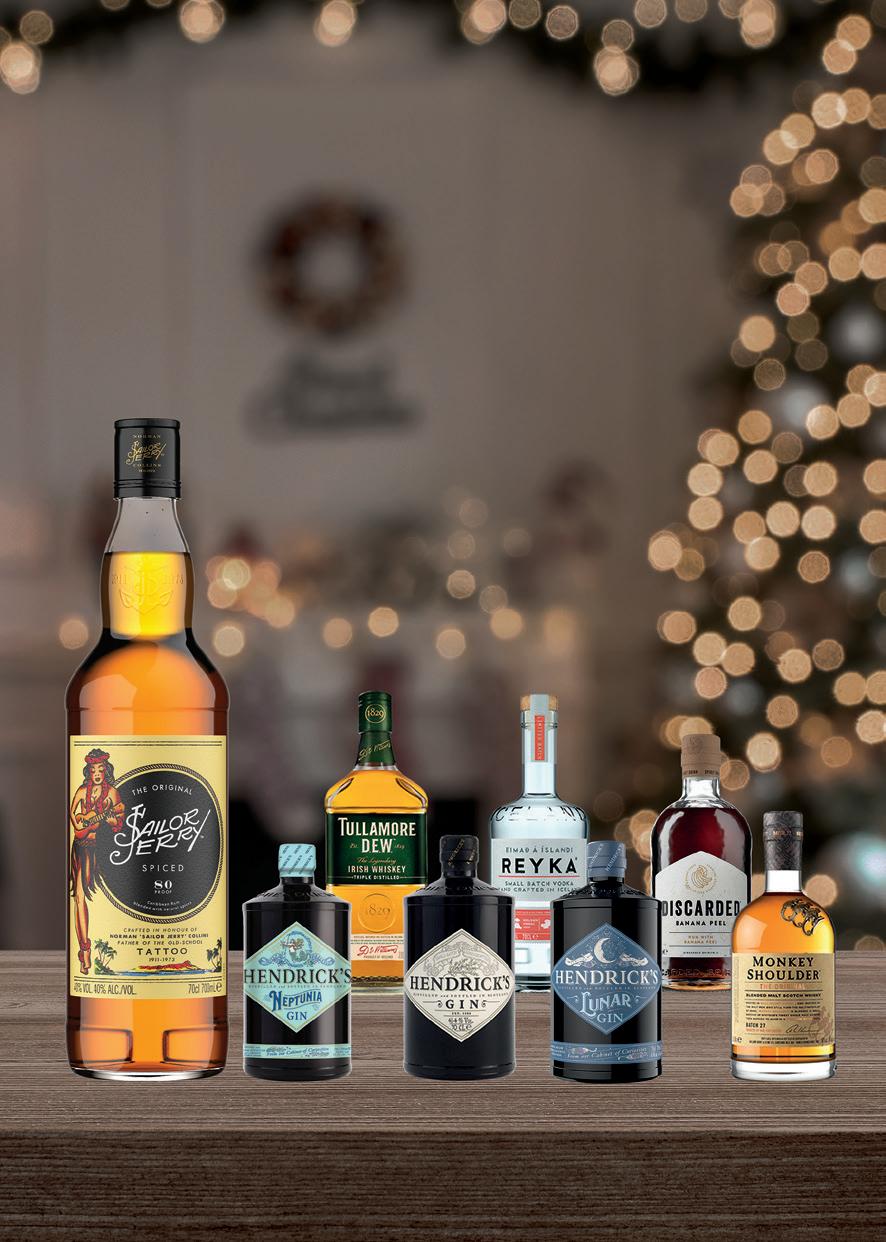




















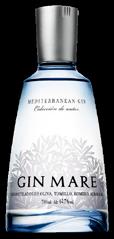












A wealth of business-building
help you make the most of your outlet, including ready-togo social assets.


Register
our weekly
hear about our latest special offers, promotions, news and training.
the first
Be the first to hear about
new product launches,
information
For technical support
customer
serve
social assets
IT’S A WIN WIN
With
Once








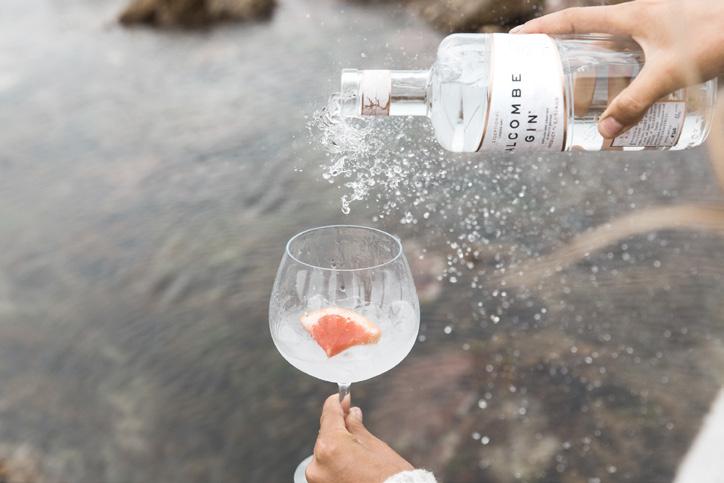





























100ml
Method: Shake ingredients and strain into a martini glass.
with
a






100ml
Method:
ingredients and
into a Margarita glass.

with a Lime wheel.
100ml Finest Call


Method: Shake ingredients and strain into a martini glass.


with
coffee beans.
100ml Finest Call Bloody Mary












Vodka
Method: Shake ingredients and strain into a tall glass





with a celery stick.








































Big Drop Brewing Co is an award-winning alcohol-free craft brewery. Our passion is brewing the finest, tastiest craft beers we possibly can. And because tomorrow is always another day, it’s alcohol free.

































The low & no category is no longer an afterthought as was previously. Many producers are now solely focusing on this category. & driving quality & demand. Consumers are also taking the category very seriously with 25% of all on trade visits not involving alcohol.

HOLY FAITH

WHITE CANE SPIRIT
Lyre’s
Rum Style
HIGH SOBRIETY
Alcohol Cider

Newtown Park x
SCAVI & RAY

LONDON
Salcombe Distilling Co
Dry Gin


Spirit
RHUBARB & GINGER
Whitley Neill

Flavoured Gin Style
Alc Spirit
ROSÉ

Lyre’s
Alcohol Cider
STOWFORD PRESS LA

Weston’s
Alcohol Cider



















Our flagship beer, brewed to an exclusive recipe that has been honed over several years. Named after the two hops that battle it out in this brew, Summit and Mosaic.
A contemporary gluten-free pale ale. Brewed to be light and easy-drinking, but also fruity and flavourful. Showcasing Centennial, Citra, Amarillo and Lemondrop hops.
A New England style IPA, brewed with wheat, oats and a huge amount of hops. The beer is opaque, intensely fruity and deceptively drinkable.
A traditional style West Coast IPA hopped with Simcoe, Citra and Chinook. Giving grapefruit flavours and aromas of citrus pith, finished with a clean assertive bitterness.
An authentic pilsner-style lager, brewed by our resident German master brewers and then matured for 65 days for a nuanced flavour experience.
A dark, smooth and silky milk stout, brewed with lactose sugar to provide a sweet finishing note that offsets the dry and roasty nature of a stout.






please get in touch to find out about the range of limited releases also available from mad squirrel in keg, cask and 440ml cans.











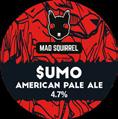
Lost and grounded brewers is a brewery in bristol, uk, established in july 2016. We are team who are fascinated by the precision of german brewing and the idiosyncratic nature of belgian beers, and we chose the brewhouse of our dreams that could help us make these wonders of fermentation.

From our flagship keller pils through to our delicious apophenia, we have a range of beers to keep you interested!
We are proud to have been a living wage foundation employer since we opened and we support the everyone welcome initiative to create a safe space for our customers as well as our team.
Sometimes the simple things in life are the best. We take pilsner malt from germany and combine with three traditional hop varities - magnum, perle and hallertauer mittelfruh - to produce a clean, unfiltered, hop bitter lager beer.
In 2021 we welcomed helles as a full-time addition to our core range. Gentle and balanced, helles exemplifies everything we aim to achieve as lager brewers. Rolling hills, open fields and happy times with friends - a reminder there are good things ahead. Helles uses the same pilsner malt blend as keller pils, and gently hopped with magnum, perle and tettnang. Soft, bready and floral.


It’s difficult to stand out in a country that is now home to more than 2,200 craft breweries. Oxford-based Tap Social Movement, however, is one brewery with a particularly compelling story to tell—and a worthy cause to support.
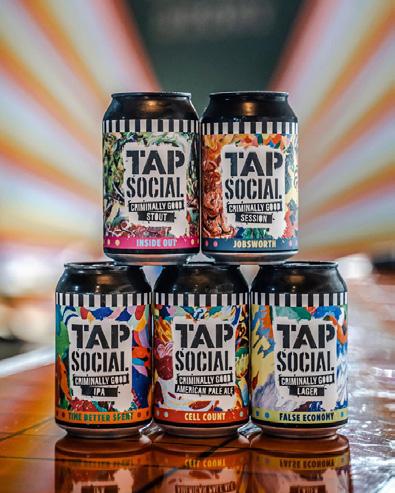
With a shared passion for social justice and craft beer, Paul Humpherson and sisters Amy and Tess Taylor founded Tap Social Movement in 2016 to provide support, training, and fulfilling employment to exoffenders during and after prison.
Armed with extensive professional backgrounds in criminal justice, nonprofit organisations, legal research, and hospitality—and, of course, a deep appreciation for craft beer—Tap Social’s cofounders decided that a brewery was the ideal platform and environment for promoting their cause and creating something special.
To date, Tap Social has generated more than 50,000 hours of paid employment for people from prison. It employs people in its brewery, in hospitality roles at its venues, in culinary roles in its kitchen and bakery, and in warehousing and delivery driving roles.

With Director Matt Elliott and Head Brewer Jason Bolger part of the leadership team, Tap Social has experienced significant growth right from the start.
After launching in 2016 with a 1,000-litre brewery in an Oxford industrial estate, a year later Tap Social relocated the bulk of its brewing to a larger facility just down the road in Kennington, where a canning line was installed and two 4,000-litre fermentation vessels were added that allowed the brewery to double its annual capacity.

In mid-2020, Tap Social introduced its core range of five modern, accessible beers, all of which are available year-round in kegs and cans from Inn Express:

• Time Better Spent – 5.1% IPA
• False Economy – 4.8% Lager
• Cell Count – 4.5% American Pale Ale
• Jobsworth – 3.5% Session Ale
• Inside Out – 5.5% Oatmeal Stout
Tap Social moved—and upgraded—again in May 2022, this time to an even bigger brewery in Kidlington. Now brewing on a 2,000-litre kit, Tap Social currently has 22,000 litres of fermentation tank space and plans to triple its annual volume.

In addition to its core beers, Tap Social also brews seasonals and special collabs at its Kidlington brewery, as well as experimental small-batch beers at its original industrial estate brewery and taproom, which is open to the public at least three days a week.
We’re thrilled to recently add Tap Social Movement to our collection of craft breweries. Stay tuned to the Inn Express newsletter for details on when Tap Social’s seasonal, small-batch, and collab beers become available, and be sure to check out their award-winning core range!

A core range is something that has constantly been requested of us from day one, but because of space, staffing, and tank limitations, we’ve been unable to fulfil. We’re now at a comfortable enough position where we feel we can produce a consistent range of beers that match the quality of our Augment range, but that we’re able to brew again and again.

Please let us introduce you to our new core range. Presenting Rosebud, Little Petal and Floret.

Our flagship core beer - the style we’re most well known for, and what we do best. Rosebud is an IPA in the New England style - the most popular variant of the style in the world. We’ve hopped this beer with Citra, Galaxy, Mosaic and Simcoe to create a certified tropical punchbowl of flavour. Strong enough to retain all that incredible mouthfeel, but sessionable enough to smash pints of.



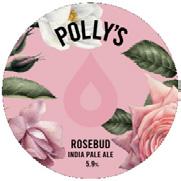

30L Keg 18 x 440ml Cans
Whilst we’re very much a brewery that produces modern, hop-forward beer, sometimes you have to look back to the old school and honour the breweries without whom we wouldn’t be here today. Little Petal takes a detour from our usual output down the Pacific highway for a deliciously moreish West Coast Pale - clean and crisp resinous bitterness takes the lead here, with a classic hop lineup of Cascade and Simcoe.


30L Keg 18 x 440ml Cans
Sometimes you just want a beer that is mega sessionable. Our Core pale ale is delicious, hazy juicebomb of a beer, balanced with enough bitterness to keep drinkers coming back for more. A baby version of our incredibly popular Spur IPA - Floret is positively bursting at the seams with peach, mango, and pineapple notes, backed up with pithy orange peel from its Citra, Simcoe and Azacca hop bill.

30L Keg 18 x 440ml Cans







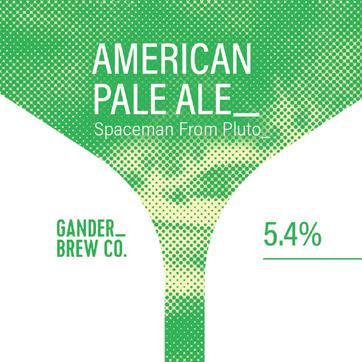












dark-brown Trappist ale
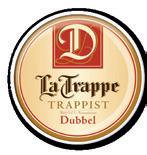

an ivory-coloured head.
malty and caramel-sweet taste

a subtle, sweet influence of dates, honey,
smooth-drinking, amber-coloured, top-fermentation beer has a honey-like mellowness, and PALM’s own selected yeasts





it a fruity yeast aroma.
















































Introducing Nightjar. With its roasted coffee notes and dry, bitter finish, this smooth and creamy British stout is something to behold.










































